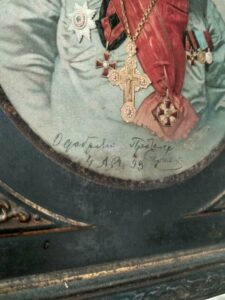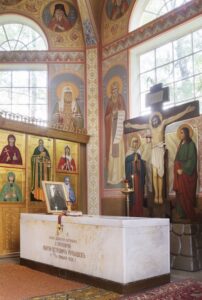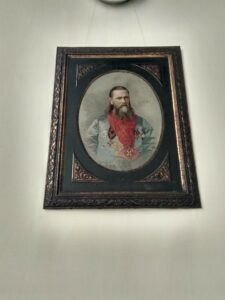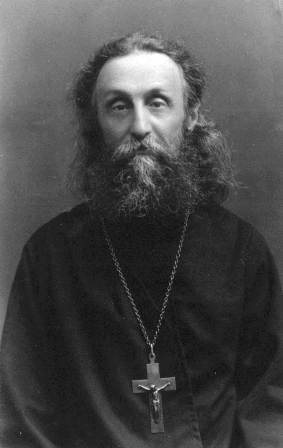Icon case with the life of St. Nicholas. The central icon have been lost and was replaced with an icon of St. John of Kronstadt. Vilnius Dormition Cathedral.
I serve in Vilnius Cathedral of the Dormition which is the historical cathedral of the Orthodox Church in Lithuania. Today it functions as a simple parish, our metropolitan lives and mostly serves the Divine Liturgy in the monastery of the Holy Spirit. It was so already in the 19th century when St. John of Kronstadt was listed as an honorary member of our parish.
St. John has left us two material gifts: a large, wooden icon case with the life of St. Nicholas the Wonderworker made by the admirers of St. John, and also his portrait (which he signed by his own hand). But he gave our country even a greater gift of his spiritual legacy, which is especially evident in the person of archpriest Pontius Rupyshev.
Fr. Pontius loved St. John since he was a little kid. When St. John came to Vilnius for the first time in 1893, the future-priest Pontius was only sixteen years old but did everything he could to see the famous Russian priest. It was not that easy: newspapers from the time report that days before St. John’s train arrived hundreds of people started gathering near the train station.
When he eventually arrived, the crowd consisted of thousands and everywhere he went he was pushed by it (also he was often accompanied by the governor of Vilnius and the most influential people from both secular and ecclesiastical hierarchy). And still the young Pontius managed to come closer to the saint. St. John took of his head and greeted the young man with a bow. This event left a deep impression on the teenager for the years to come.
A dedication on the icon case in Vilnius Dormition Cathedral. “This icon case was built by the admirers of pastor Fr. John Ilyich Sergyev of Krondstat who blessed the congragation of Vilnius Dormintion Cathedral with an icon of St. Nicholas the Wonderworker on August 28th in 1907 and who was an honorary member of this parish.“
Of course, this encounter was not the only one, but it drew him even closer to St. John. In his writings Fr. Pontius calls St. John ‘equal-to-the-apostles’ (that’s before his official canonization!) and ‘one of the greatest Russian saints’. And you can clearly see the influence of St. John on Fr. Pontius’ life choices, spirituality and worldview. He became the continuer of St. John’s spiritual work in Lithuania.
Early years and the priesthood
Pontius Rupyshev was born in 1877 in a family of a Russian court councillor (a kind of civil servant in the Russian empire). At that time his family lived where his father served – in the town of Ašmena (Ashmyany). Although today this city is in Belarus, its Lithuanian name gives away its connection to Lithuania. It is just 50 kilometers (31 miles) away from the capital of Lithuania (Vilnius) and in 19th century it belonged to Vilnius governorate of the Russian empire. So when later his father was given a higher position, it was located in Vilnius and the family moved.
Pontius’ childhood wasn’t easy. When Pontius was born, nobody really believed that he will manage to survive more than a few days. The baby was very weak and his parents hurried to baptize him. They didn’t care for the name and the priest (who was Fr. Pontius’ grandfather) simply chose a name from the calendar. On that day, 5th of August the Church commemorated holy martyr Pontius.
To the surprise of the parents, the baby lived (and eventually managed to reach the honorable age of 62 years). His unexpected survival and the second marriage of the father after the death of his mother made him kind of an unwanted child. Besides that, he struggled with his health for all of his remaining life.
He finished the school in Vilnius and was admitted to Moscow University but couldn’t finish his law studies because of his poor health. He tried again in St. Petersburg’s University (and at that time he met St. John once again) but just couldn’t make it. He wished to leave the secular life in order to become a monk, but his father disapproved of this idea.
In order to earn a living, Pontius became a parish psalmist and for some time lived in different monasteries without becoming a monk. His spiritual superiors noticed his spiritual efforts and sincerity and proposed Pontius to become a priest (his father approved of this). He independently prepared and passed the general theology exam in Vilnius seminary, which made him eligible to the priesthood.
In 1901 at the age of 24 he got married and was ordained to the holy priesthood. Fr. Pontius was assigned to serve as a dean of a church in Naujoji Vilnia (which today is a part of Vilnius but at that time was a separate town) and he also worked as a teacher of religion in three different schools.
In 1905 he was re-assigned as a teacher of religion to Babruysk (it is much further away in Belarus) and later on to Mogilev. In 1911 after a conflict with a local bishop he and his family left for St. Petersburg where they stayed at his mother-in-law. He visited St. Petersburg from time to time since his student years so he was no stranger to the city.
During his past visits and stays in St. Petersburg Fr. Pontius interacted with his beloved saint John of Krondstat. They served the Divine Liturgy together multiple times; he had multiple opportunities to speak alone with the saint. St. John gave his cassock to Fr. Pontius as a gift. Fr. Pontius considered St. John to be his spiritual father and even asked for his blessing in order to become a priest. He looked up to his beloved saint.
In 1911 Fr. Pontius was assigned to serve as a chaplain to the Russian naval forces. He served as a military chaplain throughout the First World War and this was how he met the Russian revolution of 1917. During the revolution it was dangerous to be a priest, let alone a military chaplain. After two years of struggle to survive during the ongoing civil war, he was warned by some workers of the hospital that the Bolsheviks have a plot to arrest and execute him. He had to run for his life and to leave his wife and children behind. He said farewell and when never saw them again in his life.

Signature on the portrait. “I approve it. Protopresbyter John Sergyev”. Vilnius Dormition Cathedral.
In 1919 he arrived at Daugavpils (today – Latvia) which at that time was a part of newly created ‘Latvian Soviet Socialist Republic’. He served there for some time as a priest, but when in 1920 the city was occupied by the Polish troops he saw a perfect opportunity to run further away from the Bolsheviks and went for it.
He came to Vilnius (or Wilna in Polish) which from 1920 to 1939 was occupied by Poland. Here he was relatively safe but all his life he considered this safety from Bolsheviks to be only temporal (and he was right, in 1940 – one year after death of Fr. Pontius – Vilnius and Lithuania were occupied by the Soviet Union).
Fr. Pontius Rupyshev and the Mikhnovo community
This was how Fr. Pontius came back to Vilnius region where he lived until he fell asleep in the Lord. It was a difficult time for the Orthodox Church in Lithuania – the community was divided and scattered. During the First World War many people of Russian nationality (Lithuanians comprised only about 8% of the local Orthodox Christians) ran away further into Russian empire while the newly created Republic of Lithuania lost its capital and its surrounding region to the Poland. In the Republic of Lithuania the ruling bishop was a hierarch of the Russian Orthodox Church while in the occupied Vilnius all the churches were subordinated to the newly-created Polish Autocephalous Orthodox Church. Neither Lithuanian nor Polish hierarchs could move freely through their Lithuanian diocese.
During the Lithuanian independence war (1918-1920) against the Bolshevik and Polish forces many churches became abandoned. Priests and sometimes even the whole parishes fled leaving empty buildings behind.
They went through the hell. Russian colonists were afraid of the possible vengeance on the part of Lithuanian and Polish nationalists while at the same time the faithful were persecuted by the Bolsheviks. Sometimes the new (or temporary) masters destroyed the Russian Orthodox churches, although for the different motives. Lithuanian and Polish nationalists could blow up a Russian church because it was Russian, while Bolsheviks could blow up a Russian church because it was a church.
In this situation of chaos Fr. Pontius came to Vilnius. As the ruling Russian Orthodox bishop couldn’t travel freely and visit the parishes of his diocese he asked Fr. Pontius to travel around and to see what is left of the diocese. The shortage of the priests was so critical, that the bishop blessed Fr. Pontius to serve wherever he wants. Thus he became a travelling preacher, who baptized and communed many lonely Christians and tried to help to those in need in ways that he could.
During one of those travels in 1921 he encountered a lovely church not far away from Vilnius (36 kilometers – 20 miles). It was a church built at Koretsky family estate. After the war the estate had only female inhabitants: widow Koretskaya lived together with her three daughters (one married and two maidens). The family church was not consecrated and had no priest so the women begged the bishop to assign a priest to it. After the initial refusal, eventually Fr. Pontius agreed to the assignment. He saw that under the impact of his preaching the women went through conversion and decided to live the Orthodox way of life. Before that they were only ‘traditionally’ Orthodox.
Their new way of life scandalized their neighbors and part of the clergy. Luckily, the local Polish bishop saw through it and didn’t intervene. He usually replied to the accusations: “I have been to the place, I have seen how they live, and I see nothing wrong with that”.
When other pious Orthodox Christians wanted to join the Koretsky sisters, Fr. Pontius encouraged the sisters to let them in under one strict condition: they must accept new people as their sisters (or brothers) and share the property accordingly. Thus the new Christian community was born which mostly consisted of spiritual sisters (but was not limited to them).
The community had both male and female members, even families. After the war many wives lost their husbands so there were many widows with children who were eager to join. Besides that the community have never became something official, like a monastery or a convent.
Fr. Pontius who had to flee from the Bolsheviks understood that the presence of them in Vilnius is only a matter of time. And, of course, the Communists will close down the monasteries and other Christian institutions. On the other hand, you can’t close down that which does not exist. How do you close down a community which has no official status, no vows and only unites ‘sisters’ who live as simple farmers?
This wise idea of Fr. Pontius enabled the community to survive through the Soviet years. They simply became a collective farm (kolkhoz, later – sovkhoz) and continued to work at the fields and pray. This year the community of Mikhnovo celebrates its 100 years anniversary (1921-2021).
The golden years
Fr. Pontius lead the community for 18 years until his death in 1939. Those one could call his golden years, zenith of his life as a pastor. He became so popular, that the small church in Mikhnovo (Mikniškės) couldn’t accommodate all those who wanted to partake of the Holy Communion. He became so popular, that even those priests who at first were scandalized by him decided to invite him to their parishes, because, every time Fr. Pontius came somewhere, where was such a great influx of people which couldn’t compare with any other day or even the visit of the ruling bishop. His sermons moved people and he was beloved by them.
When you read about his apostolic work (as archbishop Eleutherios have called it) you can’t avoid seeing the parallels with the mission of St. John of Krondstat. Fr. Pontius followed his beloved saint in every way: he had a diary where he would write down his experiences, he served the Divine Liturgy as often as he could (almost every day), and he was celibate in spite of being married (of course, he didn’t chose it the way St. John did). In the Mikhnovo community he taught the sisters to partake of the Divine Mysteries three times a week!
That’s a shocking number, if you think about it. If you open a Russian Catechism of St. Philaret from the 19th century, the question no. 343 reads as follows: “Ought we to communicate often in the holy Mysteries? […] Our Mother the Church calls on all, who would live religiously, to confess before their ghostly Father, and communicate in the Body and Blood of Christ, four times yearly, or even every month, but requires all, without exception, to receive it at the least once in the year.” But Fr. Pontius communed almost every day and taught his sisters to partake of the Communion three times a week! Today it might not that abnormal but only because of the St. John of Kronstadt who was one of the ‘frequent Communion’ movement leaders, who served every day.
Like St. John he also had a charism of healing, although it was not that important in his ministry. The Community believed in the God’s power to heal people and even the Fr. Pontius himself was healed by the prayers of the community.
The Mikhnovo community was organized as a sorority with elder sisters (originally the Koretsky sisters) who would act as organizers and simple sisters (and brothers) who had their duties. Those who wanted to live with the community but for one reason or another didn’t want to join fully could live at the ‘guest house’ where they would be fed but also would have to do the labor together with the sisters.

Tomb of Fr. Pontius. The text says: “Our dear batyushka Fr. Protopresbyter Pontius Petrovich Rupyshev, 10/23 January 1939.”
The end of the earthly life of Fr. Pontius
In 1939 Fr. Pontius’ health deteriorated to the end. On January 10th he sat down at his bed and the sisters read the prayers ‘for the departure of the soul’. At one moment he lifted up his eyes as if he saw the heavenly world and then he peacefully departed. His funeral services took five days and crowds have gathers to say farewell.
He didn’t leave the sisters alone – even when he was still alive he appointed the spiritual father who would succeed him and he also prepared elder sisters for his absence. He also used to say: “Don’t worry if I will depart! I will be able to help you even more!”
Witnesses say that his body was incorrupt. Today he is buried in a chapel built next to the church where he served. The sisters come to ‘speak’ with him and believe that his promise was fulfilled – that he intercedes for them before the Lord and can help them today even more than back then.
Fr. Gintaras Jurgis Sungaila is a priest from Vilnius, Lithuania and a doctoral student in Vytautas Magnus University. He serves in Vilnius Cathedral of Dormition and is one of the translators of Orthodox liturgical texts into Lithuanian. He is an author of many popular and some scholarly articles, a former radio host and he has a website dedicated to Orthodoxy (in Lithuanian): http://www.ortodoksas.lt.


